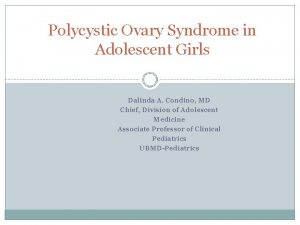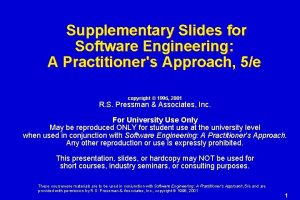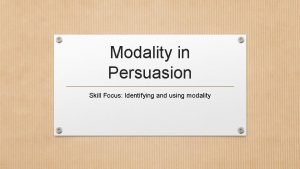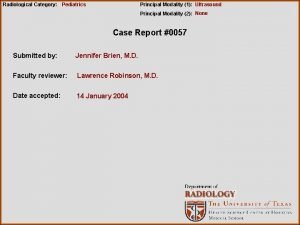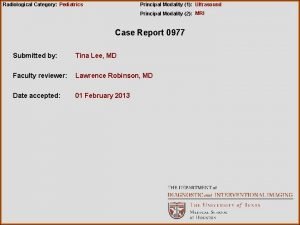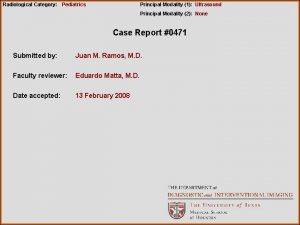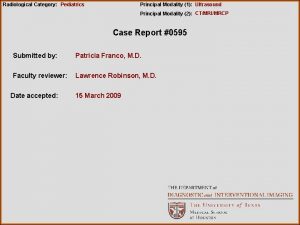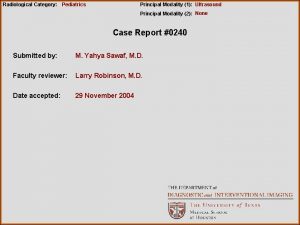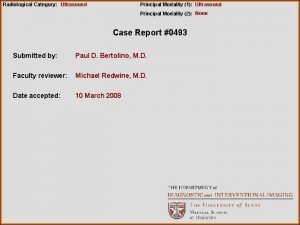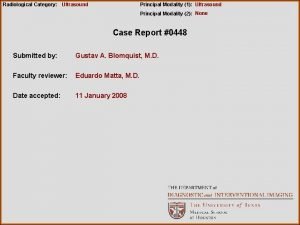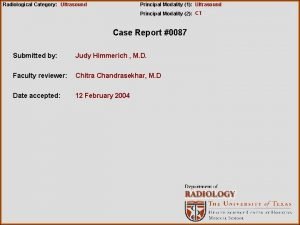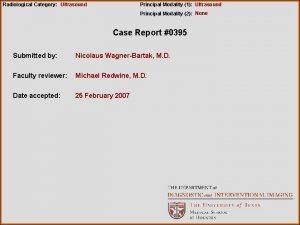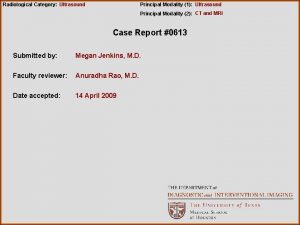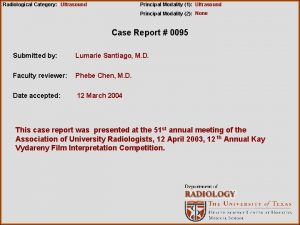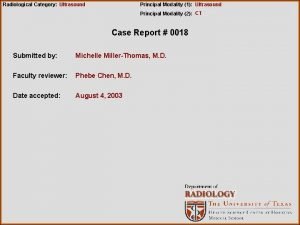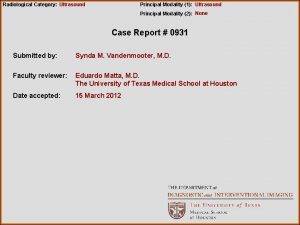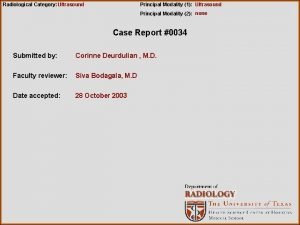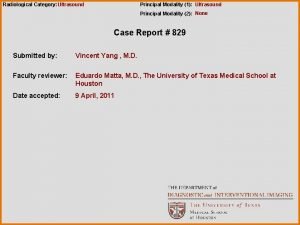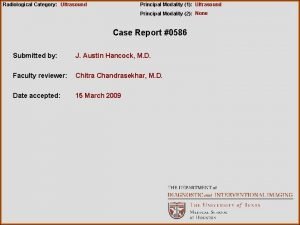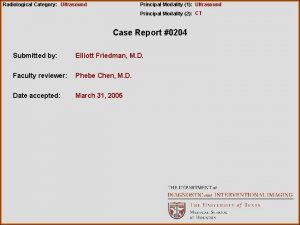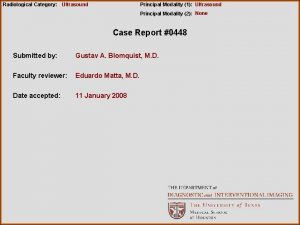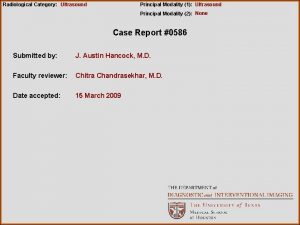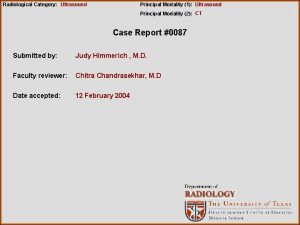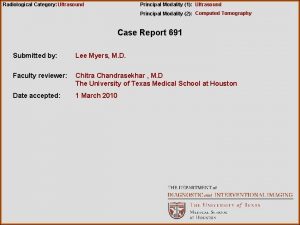Radiological Category Pediatrics Principal Modality 1 Ultrasound Principal

























- Slides: 25

Radiological Category: Pediatrics Principal Modality (1): Ultrasound Principal Modality (2): CT Case Report #0368 Submitted by: Jin T. Kim, M. D. Faculty reviewer: James Crowe, M. D. Date accepted: 15 February 2007

Case History • 16 -year-old male who noted a swelling in his neck over the past couple of months. On examination, it was noted to move with the patient's tongue and with swallowing. An ultrasound was ordered to evaluate for possible drainable fluid collection.

Radiological Presentations Trans Mid Neck Area

Radiological Presentations

Radiological Presentations

Radiological Presentations

Radiological Presentations

Radiological Presentations

Radiological Presentations

Radiological Presentations

Radiological Presentations

Radiological Presentations

Radiological Presentations

Radiological Presentations

Radiological Presentations From Atlas of Human Anatomy, Netter FH, Ciba-Geigy Corporation.

Radiological Presentations

Radiological Presentations

Test Your Diagnosis Which one of the following is your choice for the appropriate diagnosis? After your selection, go to next page. • Ectopic (or lingual) thyroid • Abscess • Congenital cystic neck mass (Thyroglossal duct cyst, Branchial cleft cyst, Cystic hygroma) • Lymphadenopathy • Malignant neoplasm (lymphoma or rhabdomyosarcoma)

Findings and Differentials Findings: Ultrasound demonstrates an oval shaped fluid collection with echogenic fluid and septation located in the anterior neck extending to the left of the midline. The lesion measures 4. 4 cm x 3. 4 cm x 1. 5 cm. On CT, a cystic structure extends caudally from the level of the hyoid bone to the thyroid gland. The lesion is located deep to the platysma, skin and subcutaneous tissues but within the prelaryngeal, prethyroid cervical soft tissues. Differentials: • Ectopic thyroid gland • Cystic hygroma • Branchial cleft cyst • Thyroglossal duct cyst

Discussion An ectopic thyroid gland is usually located between the foramen cecum of the tongue and the epiglottis in a midline position. Its frequency is 1 in 100, 000. It is usually diagnosed with nuclear medicine scans. If no thyroid gland is located in its usual location, this diagnosis should be considered. A cystic hygroma (also call lymphangioma) is a benign congenital cystic mass and results from congenital blockage of lymphatic drainage. 50% of cases present at birth and 90% are diagnosed before the end of the second year. Common locations are the neck (75%) and axilla (20%). The usual presentation is a painless, compressible mass in the posterior triangle of the neck. The lesion may infiltrate anteriorly and posteriorly and may cause airway and esophageal compression. On US, CT, and MRI, cystic hygroma appears as a thin-walled multilocular fluid-filled mass. The echogenicity may be higher than that of simple fluid due to hemorrhage, infection, or high lipid content. There is an association with chromosomal abnormalities.

Discussion A branchial cleft cyst develops when there is failure of obliteration of the branchial clefts. The branchial cleft cyst presents as masses in the upper lateral neck along the anterior border of the sternocleidomastoid muscle and is found in patients between 10 and 40 years of age. An infected cyst may be tender and painful. On US, CT and MRI, the branchial cleft cyst appears as a sharply marginated, thinwalled fluid-filled mass in the lateral neck.

Discussion The thyroglossal duct cyst is the most common of the congenital cysts in the neck. The thyroglossal duct is the epithelial tract along which the thyroid gland descends to its final position from the foramen cecum at the base of the tongue (at the 3 rd week of gestational age), to the lower neck. The duct usually involutes by the 810 th week of fetal life. In 5% of cases, thyroid cells may remain in the thyroglossal duct and give rise to thyroglossal duct cysts. It presents as an enlarging painless neck mass. 50% are less than 10 years of age at presentation, with a second peak at 20 -30 years. There is no sex predilection. The lesion is located in the midline or paramedian (usually on the left) between the thyroid gland the hyoid bone. The midline location of the thyroglossal duct cyst helps to differentiate it from a branchial cleft cyst and cystic hygroma. A thyroglossal duct cyst will characteristically move with swallowing. The thyroglossal duct cyst usually does not appear as a simple cyst and sonographically appears as a cystic lesion with low-level intraluminal reflectors, presumably due to bleeding or infection. Complications include infection, thyroid carcinoma (rare), and squamous cell carcinoma (even rarer).

Radiological Presentations – Embryology of Thyroglossal Duct From Larsen WJ. Human Embryology, 2 nd Ed. 1997. Churchill Livingstone, New York

Diagnosis Thyroglossal duct cyst.

References Dahnert W. Radiology Review Manual. 5 th edition, 2003, Philadelphia, Lippincott Williams & Wilkins. pp 369 -370, 384 -385, 394. Middleton WD, Kurtz AB, Hertzberg BS. Ultrasound: the requisites. 2 nd edition, 2004, St. Louis, Mosby. pp 245 -246. Siegel MJ, Coley BD. Pediatric Imaging: The Core Curriculum. 2006. Philadelphia, Lippincott Williams & Wilkins. pp 3 -9. Smith JC, Johnson JT. Neck cysts. http: //www. emedicine. com/ent/topic 283. htm 2006.
 Ferriman-gallwey score
Ferriman-gallwey score Erate pa
Erate pa Radiological dispersal device
Radiological dispersal device Tennessee division of radiological health
Tennessee division of radiological health Center for devices and radiological health
Center for devices and radiological health National radiological emergency preparedness conference
National radiological emergency preparedness conference Modality microsoft services
Modality microsoft services Epistemic modality
Epistemic modality Sodality vs modality
Sodality vs modality One to many relationship line
One to many relationship line Modality in statistics
Modality in statistics Cardinality and modality
Cardinality and modality Entity class in software engineering
Entity class in software engineering Deontic and epistemic modality exercises
Deontic and epistemic modality exercises Imaging modality
Imaging modality Cardinality and modality in database
Cardinality and modality in database Stefan savi
Stefan savi Modality in software engineering
Modality in software engineering Pacs modality workstation
Pacs modality workstation Modality in software engineering
Modality in software engineering Sensory vs somatic
Sensory vs somatic Deontic modality
Deontic modality Lexical vs auxiliary verbs
Lexical vs auxiliary verbs Medium modality
Medium modality Cardinality and modality
Cardinality and modality Swd modality
Swd modality
